大学英语跨文化交流第一章ppt课件
跨文化交际PPT演示课件
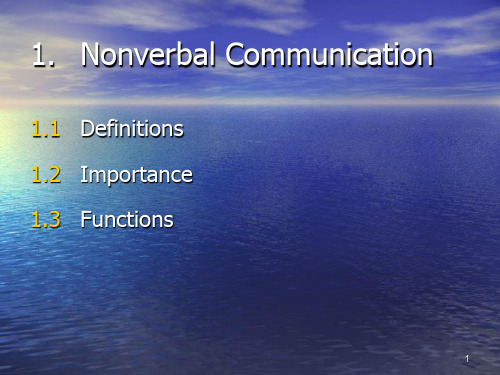
3. Space and Distance
3.1 Proxemics 3.2 Attitudes Toward Crowding
24
3.1 Proxemics
✓ Definition: the study of people’s perception and use of space.
✓ Four categories: intimate, personal, social, and public distance.
26
Categories of Distance (cont’d)
• Social Distance (1.3-3m) - colleagues, business partners, people at social gatherings
• Public Distance (beyond 3m) - speaking in public
- direct intrusion into others’ affairs • Shrugging shoulders
- indifferent, powerless, having no secret to conceal
19
Postures (cont’d)
• Follow one’s natural habits so often go unnoticed (subconscious in nature)
• May damage your image if you neglect your postures
20
2.4 Eye Contact
Direct eye contact • Chinese: avoid • North Americans: appreciate • The British: avoid
Unit_1_跨文化交际ppt

CONTENTS
I. Warm-up Cases II. What Is Culture, Communication and Intercultural Communication? III. The Differences between Chinese and Western Cultures IV. Summary V. Assignments
I. Warm-up Cases
Please discuss the cases in groups and
make a comment on it.
Case 1: Showing Concern In China: Xiao Li (an interpreter): You must be very tired. You’re old… Catherine (an elderly American lady): Oh, I’m NOT old, and I’m NOT tired.
being young that many people consciously, or subconsciously, are not willing to accept that they are growing old.
In the oing now? Would you like to rest? B: No, not a bit.
The way of showing concern is different.
In China statement
In the West question
must
how would
Case 2 First Offer
A Canadian colleague and I traveled to Guilin with our admirable guide Heping Liu in very hot weather. Sightseeing is a thirsty business. We did not trust the water, and enjoyed excellent beer. We politely offered some to Heping but he refused. We said nothing and drank our beer, while poor Heping watched. On another day, Heping quickly accepted our offer of beer. Questions for discussion In your daily life, do you often accept first offer? If yes, in what situation?
跨文化交际-unit-1Communication1PPT课件

• 适当的作笔记;
• 关注对方的肢体语言
– 面部表情 – 姿势 – 个人空间 – 语音语调
.
57
What is culture?
• The term “culture” was first used in this way by the pioneer English Anthropologist Edward B. Tylor (1832-1917)in his book,
.
17
紧张程度
演讲紧张的根源
紧张程度
听众数量 根源(1)观众的数量规模
同类演讲次数
根源(2)内容的熟悉程度
.
18
关于成功者
做别人不敢做的事 做别人不愿做的事 做别人做不了的事
成功其实开始于下定决心
并全力以赴
.
19
演讲成功四要素
明确目标 以终为始 知彼知已
组织内容
主题大纲 加味添料 注重细节
.
29
人类大脑记忆的信息
• 听到的_2_0_%__ • 看到的_3_0_%__ • 看到并听到的_5_0_%__ • 做过的_7_0_%__
.
30
注意力和兴趣曲线
.
31
加味添料
❖ 多媒体 ❖ 适当的幽默 ❖ 人性故事 ❖ 针对性的问题 ❖ 比喻/证据/示范
❖ 实验 ❖ 案例 ❖ 游戏 ❖ 实践演练
呈现形式 用图表说话 PPT制作常识
.
预演彩排 开场白与结束
避免事项
20
演讲的目的——以终为始
❖ 人生的意义 ❖ 成功的标准 ❖ 演讲是为听众,而不是为自己 ❖ 听众最关心什么
.
21
听众的要求——已所欲,施与人
文化与跨文化交际——大学英语视听说 教学课件Unit 1
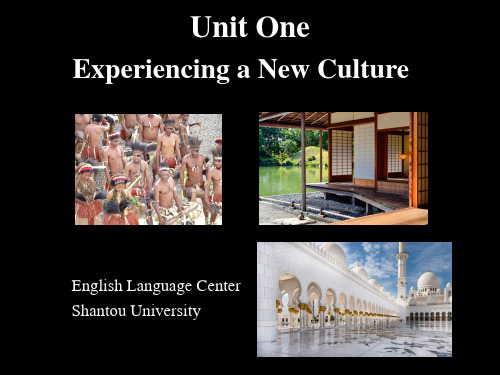
Watch the video again, and figure out the answer to each of the following questions.
assign corridor headmistress
bleep
1. to give or allocate 2. long passage in a building or train,
especially with rooms on either side 3. a female headteacher 4. a short, high sound made by a
What does “Beverly Hills, 90210” imply in the context?
A. a phone number B. a mail address C. a life style D. a hot spot
Speaking and Critical Thinking
machine, especially if it is repeated
Useful words and expressions
medieval 5. related to the Middle Ages (= the
period in uropean history from about
AD 600 to AD 1500)
Listening and Speaking Tips
How do you read each of the following sentences? What do you expect them to sound like when others read or say them?
跨文化交际Unit 1课件
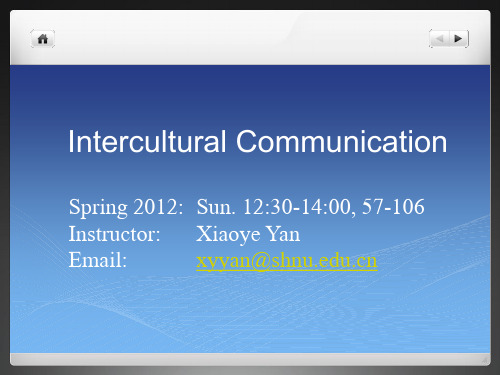
Verbal Communication
- Names of objects
- Cultural connotations of words
- The way people use languages
Intercultural Communication : An Introduction 3
Nonverbal Communication - gestures and postures
The Challenge of Globalization
Attitudes towards globalization: - both a fact and an opportunity; - the development of a global mind-set
Cultural diversity must be recognized and appreciated
The
A brief history of the study of ICC
1946: Foreign Service Institute was established in the US 1959: The Silent Language by Edward T. Hall, an American anthropologist, was published, marking the emergence of ICC 1966: ICC was regarded as curriculum in the US 1970: ICC was recognized as an independent area of study by the International Communication Association
跨文化交际unit 1 课件

Introduction to the Course▪1. Aim of the course: understand the cultural differences; communicate more effectively with people from other cultures▪2. Importance of the course:▪a. important for improving general cultural awareness▪b. can be applied in the training of business executive and technicians▪c. training of new immigrants and foreign students▪d. important in foreign language teaching and learning▪3. Way of learning: a. lecture; b. discussion;▪ c. research▪4. Assessment: 70% for final examination▪15% for PPT demonstration or research paper(>800 words)▪15% for class participation and attendance (AQs>3 times)▪5. Textbooks▪Language and Culture 刘润清邓炎昌外语教学与研究出版社▪Intercultural Communication 胡超编著外语教学与研究出版社▪《跨文化交际学概论》胡文仲著外语教学与研究出版社▪Intercultural Communication in Business 王维波,车丽娟主编外语教学与研究出版社Case Study 1▪In China:▪Xiao Li(an interpreter): Y ou must be very tired. Y ou’re old…▪Catherine(a n elderly American lady): Oh, I’m NOT old, and I’m NOT tired.▪In the West:▪A: How are you doing now? Would you like to rest?▪B: No, not a bit.Case Study 2▪In China, it is common to turn on the TV when visitors come to your home. Why?▪The intent is to be sure that your visitors are properly entertained.▪This is a case where the opposite is true in the United States.▪If a person or a family is watching the TV when visitors arrive, it is expected that the TV be turned off (or at least the sound turned dow n) immediately so that one’s full attention may be given to the visitors.Suggested topics for presentation▪1. Watch the movie 《刮痧》and list out the cultural conflicts and discuss them.▪2. What are the similarities and differences between Chinese and English table manners?▪3. What are the taboos related to Chinese Spring Festival and English Christmas?4. Find a copy of English menu and explain it to the class.▪5. Role-play a job interview with your partner.▪6. Compare English and Chinese humor.Unit One IC, Culture, Language and CommunicationUnit 1 Intercultural Communication1.1 Definition of intercultural communication▪It refers to the communication between different cultural backgrounds.▪a phenomenon (跨文化交际) –universal, long existed▪a discipline(跨文化交际学)--first started in the United States. 1959, Edward Hall ―The Silend Language‖ immigrants, foreign students and tourist multi-national and transnational companies1.2 Components of intercultural communication▪a. International communication:▪e.g. Japanese Prime Minister〈--〉American president (this is the communication between two nations)▪b. interracial communication: e.g. Afro American 〈--〉White American▪c. inter-ethnic communication e.g. Tibetan〈--〉Han (they are from different ethnic groups)▪d. inter-regional communication: e.g. A northerner 〈--〉A Southerner1.3 Reasons for the increased intercultural communication▪1. Mobile means of transport▪2. Easy and convenient communication channel▪3. Globalization of world economy.▪4. Mass migration.1.4 Three contributors to successful intercultural communication▪(1) the positive feeling we possess at the affective level, inc luding affirmation, self-esteem, comfort, trust, and safety;▪(2) the beliefs we bring into the intercultural encounter at the cognitive level, inc luding expectations, stereotypes, uncertainties, and misunderstanding of rules or procedures;▪(3) the actions or skills we possess at the behavioral level, including verbal and nonverbal communication skills in intercultural settings.Section 2. Culture2.1 The importance of adequate knowledge of culture▪1. it is necessary for the survival and existence of human beings as human beings.▪Evidence: (1) Wild boy of A veyon (2) wolf children of India▪Victor of Aveyron (also The Wild Boy of Aveyron) was a boy who apparently lived his entirechildhood naked and alone in the woods before being found wandering the woods in France in 1797. ▪wolf children, also known as wild children, are children who've grown up with minimal human contact, or even none at all. They may have been raised by animals (often wolves) or somehow survived on their own. In some cases, children are confined and denied normal social interaction with other people.3▪2. It is necessary in learning a foreign language. In a way, learning a foreign language is learning a foreign culture. It is significant to get the acquaintance with cultural differences and understanding target culture▪Examples: cases of misunderstandings between people from different culturesCase Study 3▪Here is a story of Litz, a Finnish and her Chinese husband.▪Here is the conversation:Litz: Dick, how long is your mum going to stay?Dick: I don’t know. I haven’t asked her.Litz: Why not ask her?Dick: What do you mean by asking her?Litz: I mean what I said. Just ask her how long she’s going to stay.▪Can you diagnose the problem in the communication?Case Study 4▪Jonathan: Ann, your English is improving.I’m pleased with your wor k.▪Ann: (Looking down) Oh, no. My Englishis not very good.▪J: Why do you say that, Ann? Y ou’redoing very well in class.▪A: No. I am not a good student.Continued:▪J: Ann, you’re making progress in this class.Y ou should be proud of your English.▪A: No, it’s not true. Y ou are a good teacher, butI am not a good student.▪Now predict Jonathan’s feeling.▪J: (He is surprised by her response and wonders why she thinks her English is so bad. He doesn’t know what to say and wonders if he should stop giving her compliments.)Continued:▪Question 1: Where do they come from?▪Question 2: Why did Jonathan feel like that?▪Question 3: If Ann is an American girl, what would she respond to Jonathan?Another conversation:▪Jonathan: Ann, your English is improving.I’m pleased with your work.▪Ann: (making eye contact) Thank you. I’ve learneda lot in this course.▪J: Y ou’re doing well and I can really see progress.▪A: I enjoy studying English. I do homework everynight.▪J: I can see that. Keep up the good work.▪A: I’ll try. Y ou are a good teacher. Y ou have helpedme a lot.▪Discussion: Did you ever experience misunderstanding in your communication with a foreigner? Or did you read anything about this? Please describe the situation and analyze the reason.2.2. Different interpretations of culture▪a.我没文化,不识字。
跨文化交际课件Unit_1

Whatever the reason behind the rule, you do not insist on offering alcohol. And while I certainly did not figure Heping for Mormon, a Muslim or a reformed alcoholic, so unconscious and so strong are our communicative competence rules that we equally politely never made a second offer of beer to Heping, who probably thought North Americans are most uncouth.
Xiao Li (an interpreter): You must be very tired. You’re old… Catherine (an elderly American lady): Oh, I’m NOT old, and I’m NOT tired.
The Chinese way of showing concern is usually expressed by statement.
American: That’s how we make people feel
comfortable. People feel friendlier toward each other when they use first names. Englishman: it’s different here. For example, when you met my boss you should have used his last name. Also there’s something else that you do that English people don’t often do. American: What’s that? Englishman: You touch people on the shoulder quite a bit, especially when you compliment them. American: I guess I’ve never thought about that before. I suppose that is what I do at home.
英语跨文化交际实用教程Unit-1(可直接使用).ppt

Never kiss parents
Fake goods everywhere
14
精选文档
Attitudes towards Westerners
Kiss and hug anytime and anywhere
Go Dutch
15
精选文档
Attitudes towards Westerners
3) To identify challenges that arise from these differences in intercultural interactions and learn ways to creatively address them.
6
精选文档
4) To acquire knowledge and develop skills that increase intercultural competence.
Young independent
29
精选文档
A farm family
A photo of Ba Jin’s Family
Insensitive to time
Tending to misunderstand
12
精选文档
Attitudes towards the Chinese People
Obey but not Follow
Being doubtful
13
精选文档
Attitudes towards the Chinese People
Catherine (an elderly American lady): Oh, I’m NOT old, and I’m NOT tired.
跨文化交际1ppt课件
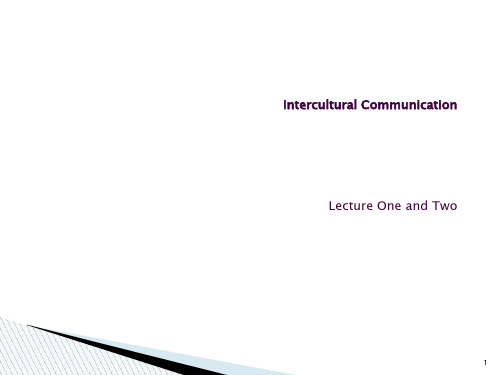
Language allows us to communicate with people who have similar value and belief system. Physical aspects supply an environment of activities and permit what we do within the culture. Finally, the psychological aspect is related to our mental activities, including what we believe and what we have learned.
2
-- To familiarize you with basic concepts of intercultural communication. The textbook introduces many of the basic concepts of intercultural communication, assuming that the more students understand about the various factors that affect intercultural communication, the more aware they will be of the role these factors play in influencing how they interpret the behavior of foreigners.
跨文化交际(精品课件)

A Monumental Figure
• Edward Twitchell Hall, (1914 –2009) , American anthropologist and cross-cultural researcher.
• Hall introduced a number of new concepts, including proxemics, polychronigh and low context cultures.
Cross-cultural communication refers to any communication between two members of any cultural communities. (Samovar and Porter, 2004:47)
11
Cross-cultural Communication Vs
his Linguistic Across Cultures(《跨文化语言学》). He discussed the cultural comparison in three aspects: form, meaning and distribution(顾嘉祖,4). • In 1959,the Silent Language by Edward T. Hall initiated the cross-cultural studies. • R.Oliver , 1962, Culture and communication • A.G.Smith, 1966,Culture and communication • In 1970s, ICA (International Communication Association) accepted Cross-cultural Communication as a branch discipline. as a discipline) • Journals: International and Intercultural Journal of Intercultural Relations.
跨文化交际课件第一章介绍Chapter One-An Introduction
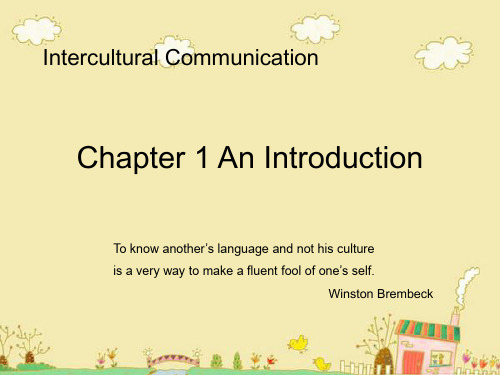
• 11. A comparative study on Western painting/architecture and Chinese painting/architecture. 12. A Comparative study on Western clothes and Chinese clothes. 13. A Comparative study on school education in America and China. 14. A comparative study on family education in America and China. 15. A comparative study on freedom concept in America and China. 16. A comparative study on wedding customs among different countries. 17. A comparative study on Western advertising and Chinese advertising. 18. A comparative study on food culture. 19. A comparative study on wine culture. 20. A comparative study on journalism in America and China.
Warm-up Cases
Case 1 Showing Concern
• In the West: A: How are you doing now? Would you like to rest? B: No, not a bit.
Warm-up Cases
跨文化交际课程第一单元(课堂PPT)

敬请光临。 We would like to have you come.
16
《笑林·寒喧》曾有一则笑话,说明汉语中 “称呼语”之复杂:
甲:你家父今年几岁?近来可安然无恙? 乙:我令尊大人今年六十有二,虽是妙龄,
5
The term “multicultural” is more frequently used in two ways. In a societal sense, it indicates the coexistence of people from many different backgrounds and ethnicities, as in “multicultural societies”. In an individual sense, it characterizes persons who belong to various discourse communities, and who therefore have the linguistic resources and social strategies to affiliate and identify with many different cultures and ways of using language.
了。
14
3.敬语和谦词
英语中有自己的表示尊重和礼貌的形式,但没有 汉语那么多的专用敬语和谦词。因此,汉语中的 “请教”、“高见”、“光临”、“久仰”、 “拜读”、“大作”、“贵校”、“敝人”、 “拙见”、“愚见”、“寒舍”、“薄酒”、 “便饭”等等敬语和谦词,很难在英语中找到等 同的表达方式,同样,英语中表示尊重、礼貌的 情态范畴,如:will、would、may、might、can、 could等等,在汉语中也没有等同的表达方式。
chapter1-1 Culture 大学英语跨文化交际 教学课件

Culture is Our Software
Software + hardware = computers culture + body = humans Culture is the basic operating system that
Grammar is made up of basic patterns, so is culture.
CUSTOMS: WHITE DRESS?
Text B DEFINITIONS OF ‘CULTURE’
According to the Concise Oxford Dictionary, culture is "the arts and other manifestations of human intellectual achievement regarded collectively".
grammar (rules) + words = language
culture + individuals = society
People use grammar even without awareness, people use cultural rules to behave properly also even without awareness.
Body (40min-50min)
Text A: The Nature of Culture
Culture Is Like an Iceberg
You see the portion above water, but perhaps not the important parts.
跨文化交际课件Unit_1

Discussion
I. Why take Intercultural Communication?
2012-2-16
4
1. Warm-up Case
Please discuss the case in groups and make a comment on it.
A Case: Showing Concern In China: Xiao Li (an interpreter): You must be
The interpreter gave the impression that he thought the elderly lady would collapse any minute if she doesn’t rest immediately.
2012-2-16
6
Comment
In the West, there is a value placed in being young that many people consciously, or subconsciously, are not willing to accept that they are growing old.
charges with modesty. But Heping did not
大学英语跨文化交流完整第一章ppt课件

A_____ P_____
.
Can you tell which of the following are above the water and which are below?
What and how people eat How to keep healthy How to raise children How to do business How to use time How to introduce people How to participate in ceremonies Rules for gestures Rules for facial expressions and eye contact Etiquette Work speed What is right or wrong, beautiful or ugly, clean or dirty, good or
.
3. Defining Culture from the Sociological Perspective
According to the social scientists: “Culture is defined as a pattern of learned, group-related perception—including both verbal and nonverbal language attitudes, values, belief system, disbelief systems, and behavior”.
.
DEFINITIONS OF ‘CULTURE’
1. Defining Culture from the Anthropological Perspective
跨文化交际第一章 PPT

However, the most common ones are racial stereotypes and gender stereotypes. Race, nationality, gender and sexual orientation are the main factors of stereotyping. Stereotyping must be avoided at all costs, as it leads to treating groups as a single entity. Given below are examples of stereotypes that people commonly use.
intentional and unintentional behavior
The second school of thought proposes that the concept of intentionality is too limiting and fails to account for all the circumstances in which messages are conveyed unintentionally. Scholars who support this approach believe communication takes place whenever people attach meaning to behavior, even if the sender of the message does not expect his or her actions to be conveyed.
跨文交际第一章
After this chapter, we will be able
- 1、下载文档前请自行甄别文档内容的完整性,平台不提供额外的编辑、内容补充、找答案等附加服务。
- 2、"仅部分预览"的文档,不可在线预览部分如存在完整性等问题,可反馈申请退款(可完整预览的文档不适用该条件!)。
- 3、如文档侵犯您的权益,请联系客服反馈,我们会尽快为您处理(人工客服工作时间:9:00-18:30)。
Learned Dynamic
Pervasive Integrated adaptive
Definition Formation Characteristics
Subculture Co-culture Subgroup
Lead-in Activity 1:
Make a list of images from your home culture and try to explain what they express about who the people of your culture are and what their relationship is to people from other cultures.
.
which image do you prefer? Which do you think are the images that most truly express how people feel about themselves and the world?
The Nature of Culture
.
1. The culture iceberg
Behaviour Traditions Artefacts – buildings, clothes, art etc.
What lies under the surface?
What lies under the surface?
cultural beliefs (e.g. how people should behave) cultural perceptions (e.g. which people are beautiful) cultural attitudes (e.g. which people are most
important in society) cultural values (e.g. what’s important in life)
? Which things below the surface influence us most? How can we become aware of our own deep culture? How can we recognize it in others?
.
Chap Nature of Definitions Characteristics Cultural
Culture
Identity
Cultures within Culture
Anthropological Psychological Sociological Intercultural
大学英语 跨文化交际
Chapter 1 Culture
.
Learning objectives :
1. Understand the definitions of culture.
2. Describe the functions and characteristics of culture.
3. Summarize the process of the formation of cultural identity.
bad, etc.
2. Culture Is Our Software
Why is culture compared to the software of people’s mind? Cite some examples to illustrate it.
The society around us is not an entirely objective reality, for everyone of us helps to construct our world. Culture is the shared set of mental and psychological principles that exist in people’ minds.
.
3. Culture Is Like the Water a Fish Swims In
.
“Out of water” = Out of Context
As a schooled fish… “Water” is my culture Other Waters or Air are
other cultural contexts “I want my context to
Think about the following similes and metaphors, how do you think culture is related to the references? 1. Culture is like an iceberg. 2. Culture is our software. 3. Culture is like the water a fish swims in. 4. Culture is the grammar of our behavior.
.
Can you tell which of the following are above the water and which are below?
What and how people eat How to keep healthy How to raise children How to do business How to use time How to introduce people How to participate in ceremonies Rules for gestures Rules for facial expressions and eye contact Etiquette Work speed What is right or wrong, beautiful or ugly, clean or dirty, good or
